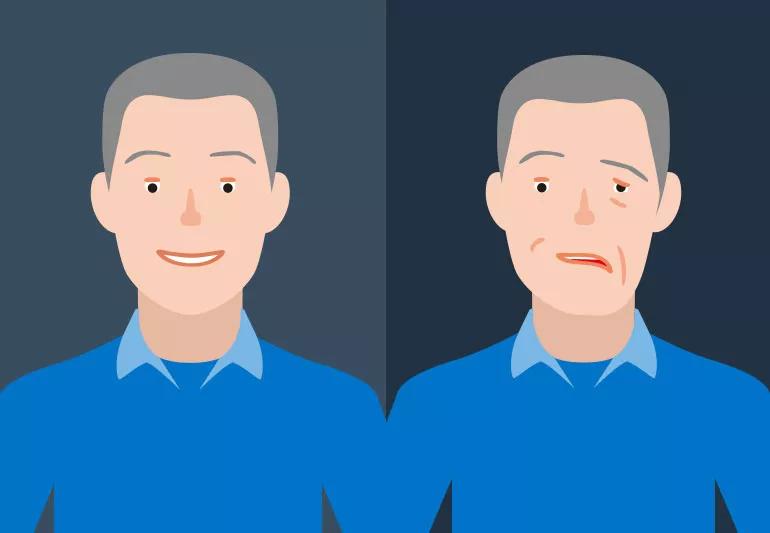The good news is, it's usually only temporary

Imagine looking in the mirror one day and noticing that your face seems to be sagging on one side, and your smile looks a little crooked. By the next day, you realize you can’t move an entire side of your face.
Advertisement
Cleveland Clinic is a non-profit academic medical center. Advertising on our site helps support our mission. We do not endorse non-Cleveland Clinic products or services. Policy
This facial paralysis, called Bell’s palsy, happens to tens of thousands of people each year. The good news is that it’s generally not permanent, but it can be a very scary experience nonetheless.
Part of the face becomes paralyzed because of damage or inflammation in the nerve that controls the muscles on either side of the face – the muscles you use to smile, blink and scrunch up your nose.
Doctors think that the nerve damage or inflammation might be triggered by a viral infection, like the herpes simplex virus or the varicella zoster virus, which causes chickenpox and shingles, says neurologist MaryAnn Mays, MD.
She says that many people initially mistake Bell’s palsy for a stroke. Although they produce a common symptom (weakness in one side of the face), the two aren’t actually related, and how they’re treated is very different.
Bell’s palsy should be treated right away, but it isn’t necessarily an emergency.
A stroke, on the other hand, is a medical emergency. If you or someone you know experience facial droop along with any other symptoms of stroke, such as numbness, weakness, slurred speech, double vision or dizziness, or if the symptoms aren’t clear-cut, call 911. It’s better to be safe than sorry.
Advertisement
Dr. Mays says there are a few additional signs that can help distinguish one from the other:
Other symptoms that someone with Bell’s palsy might experience include:
After doing an exam and diagnosing Bell’s palsy, a primary care doctor or urgent care clinic can prescribe an oral steroid such as prednisolone to help ease the swelling around the nerves in the face.
The doctor might also prescribe an anti-viral medicine in addition to the steroid if they suspect it’s related to an underlying viral infection.
Treatment is most successful when it begins within 72 hours, Dr. Mays says, so it’s important to see a doctor quickly.
How long does it take for someone with Bell’s palsy to be able to move their face again?
Everyone is different, but, “as a rule of thumb, usually within three weeks people will start to get some improvement,” Dr. Mays says.
For some people, though, recovery may take a few months.
In the meantime, it’s important to protect the eye on the side that’s paralyzed, since it won’t be able to protect itself by blinking or closing.
“We want to make sure that the patient can fully close their eye when they’re sleeping – we recommend covering the eye up with either a patch or a piece of tissue or hanky taped over the eye so that they don’t get any scratches on the cornea,” Dr. Mays says.
Most people will not need treatment beyond medication. Some people use additional treatments to help their recovery, but Dr. Mays notes that there aren’t a lot of scientific studies showing that these methods do speed up or improve recovery. They include:
If symptoms haven’t cleared up after eight weeks, a doctor might want to do an MRI. Rarely, the facial nerve loses its way as it heals and grows back. This can lead to unintentional movements of facial muscles, like the eye blinking when someone smiles.
But usually, Bell’s palsy goes away and isn’t a sign that something else is wrong. By taking prednisolone as instructed, caring for the affected eye and following up with a doctor, most people can recover and get back to their normal quality of life.
Advertisement
Advertisement
Learn more about our editorial process.
Advertisement

At-home options aren’t your best bet — instead, consider noninvasive laser treatments with a dermatologist

Mewing is a tongue exercise that some believe can straighten teeth and sharpen jawlines (Spoiler alert: It can’t)

Understanding Fifth disease

Common symptoms include chest discomfort, shortness of breath, nausea and profuse sweating

A vagus nerve reset can help to relieve stress and find calm

After knee arthroplasty, swelling-related pain is common, but infection and blood clots are also risks

Early morning red eyes can be a sign of several conditions, like dry eyes, allergies and eye strain

See an eye specialist if your pain isn’t going away and comes with other symptoms

Start having sex about 72 hours before ovulation, then at least every other day during your fertile window

Attachment theory suggests that your earliest relationships shape connections throughout your life

It isn’t a recognized mental health disorder, but research shows that problematic social media use can negatively affect your mental health, self-esteem and sleep